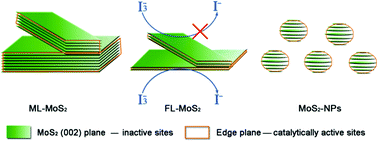Morphology dependence of molybdenum disulfide transparent counter electrode in dye-sensitized solar cells†
Abstract
Molybdenum disulfide attracts additional attention due to its layered structure which allows transformation into a two-dimensional morphology, like graphene. In this paper, three kinds of molybdenum disulfides with distinguishable morphologies, i.e. multilayers, a few layers and nanoparticles, are prepared and used as counter electrode materials for dye-sensitized solar cells (DSSCs). The characterization results from X-ray diffraction (XRD) and transmission electron microscopy (TEM) demonstrate that the molybdenum disulfides have an obviously different edge area to basal-plane ratio, with the order: synthesized MoS2 nanoparticles (MoS2-NPs) > multilayered MoS2 (ML-MoS2) > few-layered MoS2 (FL-MoS2). It is interesting that the MoS2 counter electrodes show the same order as above in the energy conversion efficiency measurements of the corresponding DSSCs. Electrochemical impedance spectra (EIS) show that the MoS2-NPs electrode has the minimum charge-transfer resistance, while the FL-MoS2 electrode provides the maximum. Combined with the results from triiodine ion adsorption experiences and N2-adsorption measurements, it is proposed that the catalytically active sites of molybdenum disulfide lie on the edges of the typical layered material, but not on the basal planes. In addition, the transparency of the FL-MoS2 electrode is obviously higher than that of the other MoS2 and Pt electrodes.


 Please wait while we load your content...
Please wait while we load your content...